The DNA methylation inhibitor RG108 protects against noise-induced hearing loss
- PMID: 33723744
- PMCID: PMC8490244
- DOI: 10.1007/s10565-021-09596-y
The DNA methylation inhibitor RG108 protects against noise-induced hearing loss
Abstract
Background: Noise-induced hearing loss represents a commonly diagnosed type of hearing disability, severely impacting the quality of life of individuals. The current work is aimed at assessing the effects of DNA methylation on noise-induced hearing loss.
Methods: Blocking DNA methyltransferase 1 (DNMT1) activity with a selective inhibitor RG108 or silencing DNMT1 with siRNA was used in this study. Auditory brainstem responses were measured at baseline and 2 days after trauma in mice to assess auditory functions. Whole-mount immunofluorescent staining and confocal microcopy of mouse inner ear specimens were performed to analyze noise-induced damage in cochleae and the auditory nerve at 2 days after noise exposure.
Results: The results showed that noise exposure caused threshold elevation of auditory brainstem responses and cochlear hair cell loss. Whole-mount cochlea staining revealed a reduction in the density of auditory ribbon synapses between inner hair cells and spiral ganglion neurons. Inhibition of DNA methyltransferase activity via a non-nucleoside specific pharmacological inhibitor, RG108, or silencing of DNA methyltransferase-1 with siRNA significantly attenuated ABR threshold elevation, hair cell damage, and the loss of auditory synapses.
Conclusions: This study suggests that inhibition of DNMT1 ameliorates noise-induced hearing loss and indicates that DNMT1 may be a promising therapeutic target. Graphical Headlights • RG108 protected against noise-induced hearing loss • RG108 administration protected against noise-induced hair cell loss and auditory neural damage. • RG108 administration attenuated oxidative stress-induced DNA damage and subsequent apoptosis-mediated cell loss in the cochlea after noise exposure.
Keywords: Cochlea; DNA methylation; Hair cells; Noise-induced hearing loss.
© 2021. The Author(s).
Conflict of interest statement
The authors declare no competing interests.
Figures

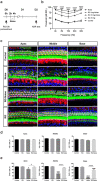

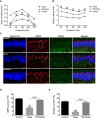


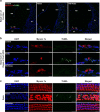

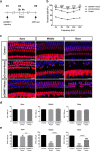
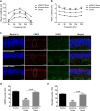

Similar articles
-
Noise induced reversible changes of cochlear ribbon synapses contribute to temporary hearing loss in mice.Acta Otolaryngol. 2015;135(11):1093-102. doi: 10.3109/00016489.2015.1061699. Epub 2015 Jul 3. Acta Otolaryngol. 2015. PMID: 26139555
-
Low Iron Diet Increases Susceptibility to Noise-Induced Hearing Loss in Young Rats.Nutrients. 2016 Jul 28;8(8):456. doi: 10.3390/nu8080456. Nutrients. 2016. Retraction in: Nutrients. 2017 Apr 25;9(4):E422. doi: 10.3390/nu9040422. PMID: 27483303 Free PMC article. Retracted.
-
Adenosine receptors regulate susceptibility to noise-induced neural injury in the mouse cochlea and hearing loss.Hear Res. 2017 Mar;345:43-51. doi: 10.1016/j.heares.2016.12.015. Epub 2016 Dec 26. Hear Res. 2017. PMID: 28034618
-
Genetic influences on susceptibility of the auditory system to aging and environmental factors.Scand Audiol Suppl. 1992;36:1-39. Scand Audiol Suppl. 1992. PMID: 1488615 Review.
-
[Hidden hearing loss-damage to hearing processing even with low-threshold noise exposure?].HNO. 2019 Jun;67(6):417-424. doi: 10.1007/s00106-019-0640-8. HNO. 2019. PMID: 30874853 Review. German.
Cited by
-
SIRT1 prevents noise-induced hearing loss by enhancing cochlear mitochondrial function.Cell Commun Signal. 2025 Apr 2;23(1):160. doi: 10.1186/s12964-025-02152-9. Cell Commun Signal. 2025. PMID: 40176044 Free PMC article.
-
Deciphering the potential ability of RG108 in cisplatin-induced HEI-OC1 ototoxicity: a research based on RNA-seq and molecular biology experiment.Hereditas. 2023 Apr 24;160(1):18. doi: 10.1186/s41065-023-00283-y. Hereditas. 2023. PMID: 37088824 Free PMC article.
-
The Information Theory of Aging.Nat Aging. 2023 Dec;3(12):1486-1499. doi: 10.1038/s43587-023-00527-6. Epub 2023 Dec 15. Nat Aging. 2023. PMID: 38102202 Review.
-
DNA Methylation of T Lymphocytes as a Therapeutic Target: Implications for Rheumatoid Arthritis Etiology.Front Immunol. 2022 Mar 3;13:863703. doi: 10.3389/fimmu.2022.863703. eCollection 2022. Front Immunol. 2022. PMID: 35309322 Free PMC article. Review.
-
S100A8 and S100A12 Proteins as Biomarkers of High Disease Activity in Patients with Rheumatoid Arthritis That Can Be Regulated by Epigenetic Drugs.Int J Mol Sci. 2022 Dec 31;24(1):710. doi: 10.3390/ijms24010710. Int J Mol Sci. 2022. PMID: 36614150 Free PMC article.
References
Publication types
MeSH terms
Substances
Grants and funding
LinkOut - more resources
Full Text Sources
Other Literature Sources

